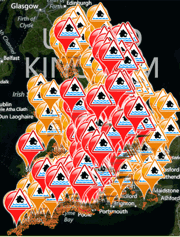The Business Continuity role in adapting to climate change
 Last winter heavy rain, storm force winds and large waves combined with high spring tides presented England with unprecedented flooding from the sea, rivers, groundwater and surface water.
Last winter heavy rain, storm force winds and large waves combined with high spring tides presented England with unprecedented flooding from the sea, rivers, groundwater and surface water.
Thousands of properties were flooded, infrastructure was damaged and tragically, eight people lost their lives. The full impact of these events has not yet been calculated but we do know that 175,000 businesses in England are at risk of flooding [note1].
 In 2012 flooding cost affected businesses an average of £60,000 [note2], so it is not surprising that flooding is a national priority. In fact the National Risk Register of Civil Emergencies cites coastal flooding as the second highest priority risk after pandemic flu and ahead of catastrophic terrorist attack (taking both likelihood and impact into account) [note3] .
In 2012 flooding cost affected businesses an average of £60,000 [note2], so it is not surprising that flooding is a national priority. In fact the National Risk Register of Civil Emergencies cites coastal flooding as the second highest priority risk after pandemic flu and ahead of catastrophic terrorist attack (taking both likelihood and impact into account) [note3] .
Other types of weather also present a source of business disruption and cost. The 2003 heatwave, for example, is estimated to have cost the UK economy around £500m. Overall, 54% of businesses were disrupted by weather in 2012 making it the top source of disruption for the fourth year running[note4].
We cannot say that an individual weather event was caused by climate change. However, we do know that we can expect an increasing frequency and severity of weather events such as heavy downpours of rain, storms, heatwaves and drought [note5].
In fact, it is estimated that climate change has at least doubled the risk of a heat wave exceeding the temperatures experienced in the European heat wave of 2003 [note6]. Although the frequency of particularly cold seasons is expected to reduce on average, we should still plan to be resilient to very cold winters, such as 2010/11, which remain possible.
 The impacts are already being observed on every continent and in the oceans [note7].
The impacts are already being observed on every continent and in the oceans [note7].
For example, there is an increasing body of evidence that extreme daily rainfall rates around the world are becoming more intense, and that the rate of increase is consistent with what is expected from fundamental physics [note8].
Businesses need to build resilience to severe weather and prepare for climate change in order to minimise disruption or costs associated with damage to properties, declining productivity, illness and accidents, changes to prices or availability of raw materials, insurance or investment.
Supply Chain Risks
 Those with globalised supply chains or markets will need consider a set of more complex and potentially more severe risks, such as impacts on developing countries that are least able to adapt, competition for water, and the potential for violent conflict by exacerbation of existing drivers such as poverty and economic shock.
Those with globalised supply chains or markets will need consider a set of more complex and potentially more severe risks, such as impacts on developing countries that are least able to adapt, competition for water, and the potential for violent conflict by exacerbation of existing drivers such as poverty and economic shock.
Climate change will increasingly shape national security policies by posing risks to territory and introducing rivalries over natural resources [note9].
 There will also be some business opportunities: Adaptation and resilience activities are estimated to be worth £65.8bn globally and £2.1bn in the UK. Transport infrastructure, construction, sustainable drainage and water management are key sectors where opportunities exist [note10].
There will also be some business opportunities: Adaptation and resilience activities are estimated to be worth £65.8bn globally and £2.1bn in the UK. Transport infrastructure, construction, sustainable drainage and water management are key sectors where opportunities exist [note10].
A key challenge for businesses, however, is in turning information and planning into tangible action.
The role of Business Continuity Management
BCM includes methods for dealing with potential and actual disruptive events as well as a remit to access and relate to all areas of the business. It is therefore well placed to incorporate efforts to manage climate risks, which require cross-cutting action and are often disruptive in nature. Indeed, a survey carried out by Continuity Forum in 2013 found that 72% of business continuity managers felt that it should be their role to lead on managing climate risks [note 11].
A new BSi Smart Guide supports the use of a business continuity management system as a starting point for managing climate risks and is compatible with the current international standards (ISO 22301 and supporting guidance standard ISO 22313). It focuses on what may be new or additional to a traditional BCM approach.
It highlights three areas where adapting to climate change may challenge an existing system:
-
Some aspects sit outside the traditional scope of BCM e.g. Non-disruptive effects or opportunities.
-
Assessment of and reaction to climate risks may not have kept pace with climate change. In other words, the likelihood of severe weather events may be greater than we imagine based on past experience and things that have not happened in the past at all could now be possibilities.
-
Climate change is a long term and dynamic phenomenon and therefore requires understanding future and changing threats (and opportunities) and how these interact with business timescales. Business continuity management tends to be focussed on short timescales and does not generally engage with long-term drivers
The Smart Guide ‘Adapting to climate change using your BCMS can be found here: http://www.bsigroup.com/en-GB/forms/Adapting-to-Climate-Change-using-your-Business-Continuity-Management-System/ and you can see a short video from the Continuity Forum on the issues HERE!
The guide breaks down the process into 13 tasks that take you from reviewing the context of the organization, developing leadership and understanding the key issues, through to putting in place adaptation measures through your BC strategy, plans and procedures and evaluating performance. Climate Ready are offering free support to businesses who would like help in working through one or more of these tasks.
For more details contact email the Environment Agency Help Desk climatechange@environment-agency.gov.uk or get in talk with the Continuity Forum Team.

11. Continuity Forum (2013)













